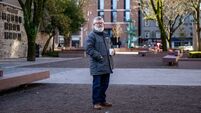Clodagh Finn: The first female sports reporter blazed a trail on her Honda 50

Dóirín Mhic Mhurchú had a gift for languages. She spoke five fluently — Irish, English, Spanish, French, Italian — and had some knowledge of Arabic, Polish, Swedish, and German.
On more than one occasion, Dóirín Mhic Mhurchú was turned away at the turnstile when she turned up to cover a football match for Raidió na Gaeltachta. When she did manage to persuade the officials that a woman was capable of covering sport, the palm of a man’s hand came up to stop her from entering the press box.
“This is for the press, Mrs,” they’d say.
“I am the press,” she’d reply.
It was the early 1970s and Dóirín Mhic Mhurchú was the station’s first and only female sports reporter. Indeed, she was probably the first female sports reporter in the country. Her children are open to correction on that, but it’s fair to say that this woman of 5ft ½in — “I am very proud of that half inch,” she used to say — pushed the boundaries as a woman sports reporter who travelled to matches, far and wide, on her Honda 50.
She never missed a match, whatever the weather. When she came home dripping and frozen, her husband Éamonn had a roaring fire going and always said it was a fright that they sent players out in that kind of weather.
By then, she would have already stopped off en route to phone in her report.
She’d balance her wire-bound notebook on a public phone and press button A — older readers will understand — as she raised her voice above the din of a local pub or hotel.
All reporters did that and recalling those low-tech days, as Raidió na Gaeltachta turns 50, is an important piece of social history.
It is also important to recall a time, not that long ago, when a woman turning up to report on a GAA match was a rare occurrence.
Indeed, the early days were so tricky that Dóirín Mhic Mhurchú made herself a press card, using Pritt Stick, a piece of cardboard, and the Raidió na Gaeltachta triskele logo. She never had an issue again, and by the time her official National Union of Journalists (NUJ) card came through, the nearly all-male listenership of Spórt an Domhnaigh had not only got used to her voice, but saw her as an authority.
She had been involved in Rinn GAA club in Co Waterford since the 1970s, holding a variety of posts from registrar, PRO, Irish language officer, to vice-president. She played too and in 1974 lined out as full forward, playing alongside her daughter Áine, to win the Junior Camogie County final. She was already a grandmother.
She didn’t just cover GAA. She reported on everything from point-to-point to pitch and putt for radio and RTÉ television, and she also wrote in English for the Irish Press, Irish Independent, The Irish Times, and Ireland’s Own, among others.
When the family got a phone installed around 1975, it was a godsend. In fact, says her daughter, writer Áine Uí Fhoghlú, to have a phone installed then was like having a swimming pool, it was such a luxury.
Her mother had a new problem, though, as she had to seek out a quiet corner of the house or banish her “unruly clutch” of five children from the kitchen so that she could write her report.
“But she never failed to meet her deadlines,” her daughter adds.
In 1978, life got easier still when she got her first car, a Mini.
While Dóirín Mhic Mhurchú never made much of what she did — “she was just earning a crust,” her daughter says — she is rightly remembered as a woman who broke through a barrier in sports journalism.
She also broke through another barrier — the language barrier. She and her husband were not allowed to open a bank account in Dungarvan, Co Waterford, in the late 1960s because they refused to provide the English version of their names. They took their business to another bank, which accepted their Irish names.
Dóirín Mhic Mhurchú’s love and mastery of the Irish language is all the more striking as she was born in Liverpool.
She heard her father Denis Harding, a doctor, speaking the language when she was a child and later took classes when working for Dublin Corporation in Dublin in the early 1950s. Her future husband, Éamonn Mac Murchú, was her teacher.
I thought of that when I filled out the census form at the weekend and wavered over the question enquiring if I spoke Irish or not. After 14 years of Irish schooling, I had to say I did, but I also had to tick the section admitting that I didn’t speak it well. I don’t think we need to wait for the census returns to know that I’m not alone.
Dóirín Mhic Mhurchú clearly had a gift for languages. She spoke five fluently — Irish, English, Spanish, French, Italian — and had some knowledge of Arabic, Polish, Swedish, and German.
But, as her son Irial Mac Murchú, CEO of Nemeton TV, asks, why do we accept that we spend so long learning a language in school, but still can’t speak it?
It is an excellent question and one that deserves more attention now that Leaving Cert reform is in the air.
Put it another way. What would happen if we came out of school after spending 14 years learning maths, but weren’t able to add?
There would be a national outcry and several enquiries. Why, then, do we allow so much school time to effectively disappear down a black hole?
We can’t blame it all on poor Peig Sayers, although we might well accuse a school system that deadened the words of a gifted storyteller. It edited them too, excising much of the colour and gossip.
It is easy to instil a love of languages, as Dóirín and Éamonn proved when they spoke Irish to their children after moving to the Australian bush in Queensland in 1960. They spent three years there before returning to Ireland and eventually settling in Rinn.

They both became deeply immersed in the local community, Éamonn as manager of the local Co-Operative shop An Stór and Dóirín as local journalist, camogie enthusiast, church organ player, and member of myriad organisations from Comhaltas Ceoltóirí Éireann and the Irish Countrywomen’s Association to the Gaeltacht Civil Rights Association.
She was a writer, author ( Bealach na Bó Finne on Gaelic pilgrimage to Santiago de Compostela was published in 1994), hand crafter, musician, composer, dancer and singer, teacher, and inveterate traveller.
The Monday before she died, aged 84 in 2014, she sat up in hospital and produced a magazine advertising trips to Turkey: “Look,” she said to her daughter, “we could get to Turkey for €129!”
Her contribution to the Irish language was recognised in her lifetime when then-president Mary McAleese presented her with an Oireachtas na Gaeilge award in 2008. But it doesn’t seem like enough.
At the very least, there should be a journalism award in her name or, better still, we might take a leaf out of her book when teaching (and learning) languages in school.
CONNECT WITH US TODAY
Be the first to know the latest news and updates











